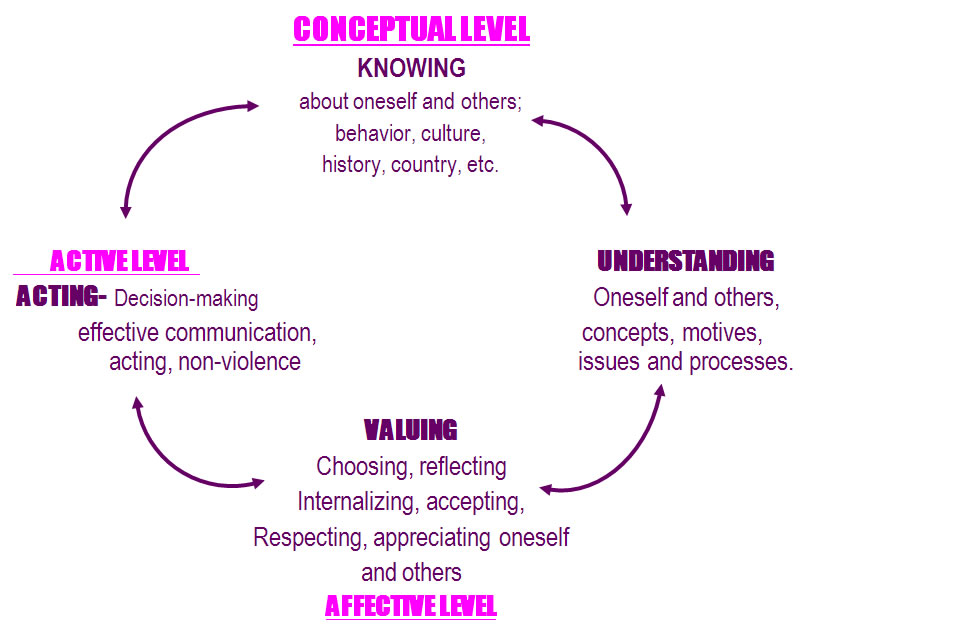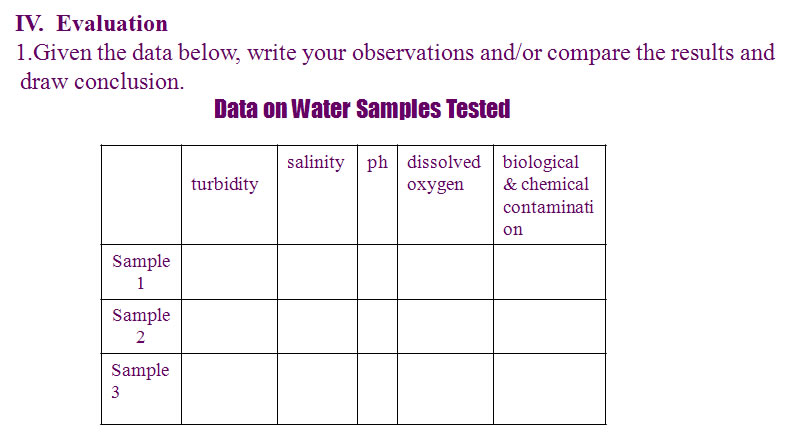<<back
Integrating Values in Lessons
Estrellita Y. Evangelista, Ed.D.
Director III, Bureau of Secondary Education
Department of Education, Philippines
•Assumptions
–The nature of values
– A common understanding of the goals of education
•The Concept of Values Integrationt
The Five Basic Human Values
•Potential Learning Areas for Values-Based Water Education
•The Context and Process of VaIues Integration
•Levels of Teaching Applied
Critical Goals of Education
a. To assist the student in
–Identifying
–Examining
–Changing these values if he so decides as long as these values donot impinge on the rights of others
b. To develop the student’s potentials to the fullest; to assist him/her to be a fully human person
•bases of judging what attitudes and behavior are correct or not (DECS VE Program, 1997)
•the overriding principles (standards, decisions, ideals) which govern and ought to govern people’s behavior;
•universal truths which man considers to be good and important;
•ethical principles which a person struggles to realize and live (Esteban, 1990)
The Nature of Values:
•Moral values - natural law; “Do good and avoid evil.”
•Clearly defined values give meaning to human activity
•the systematic development of values require a methodological support which cannot be neutral. It demands discussion, processing, reflection and actions.
The Concept of Values Integration
Values Integration is a channel of values development through the teaching-learning activities in the different learning areas.
The starting point of values integration is the nature of the learning areas and their unique contribution as bodies of knowledge.
Teachers first identify the concepts to be developed in the lesson;
then, develops the values inherent in the subject
•The Concept of Values Integration
Values Integration does not mean quoting a value and discussing it.
•It is Leading the students to see a personal meaning in whatever teachers teach in the classroom
CORE VALUES (DepED Values Education Program, 1988)
1.Physical - Health and Harmony with Nature
2.Intellectual- Truth and tolerance
3.Moral - Love and Goodness
4.Spiritual - Global spirituality
5.Social - Peace and Justice
6.Economic – Sustainable Human Development
7.Political - Nationalism and Globalism
The Basic Human Values (United Nations Centre for Human Settlements, 2001, p.23)
•Truth
•Love
•Peace
•Right Conduct
Practical Learning Areas for Values-Based Water Education
•Mathematics
•Science
•English
•Social Studies
•Civics/Citizenship Education
•Home Economics
•Physical Education and Health
•Mathematics
Nature
•Determines quantity
•Training of the mind (from concrete to abstract)
•Ability to think clearly and logically
•Independence of thought
and flexibility of mind
Inherent Values
•Respect for truth
•Confidence
•Persistence through sustained work
•Awareness of the use of mathematical skills in the world beyond the class-room.
•English
Nature
•Concerned with skills of, discovery and eval-uation (Paffard, 1978)
•Deals with levels of personal experience
•Concerned with personal growth and with cultural heritage of a nation (Dixon 1967)
Inherent Values
•Response of reader to the work as a whole makes demands on his intelligence, moral insight,capacity to res-pond to values embodied in the reading
•Concern for explicit and implicit values
•Influence on one’s beliefs and values and behavior
•Science
Nature
•Longing to know and understand
•Search for data and their meaning
•Demand for verification
•Questioning mind
–How do we know?
–Why do we believe it?
–What’s the evidence for this?
Inherent Values
•Respect for logic
•Seeking for truth
•Consideration of premises
•Consideration of conse-quences
•Social Studies
Nature
•Understanding of a society’s culture.
•Deals with man as social being; how he relates with his neighbor and the envi-ronment (Marsh, 1990)
•Appreciation of history and cultural development
Inherent Values
•Social understanding
•Responsible citizenship
•Search for peace
•Greater social awareness
•Concern for society
•Home Economics
Nature
•Identification of human needs: food, clothing, housing, care, security, human relationships
•Organization and management of resources to meet human needs.
•Household and community interrelation-ships
Inherent Values
•Care and concern for others
•Frugal and simple life- style
•Independence and per-sonal responsibility
•Pleasures of homemaking and the joys of family life
•Appreciation of diffeent value systems—cultural, religious, regional, national
How can teachers naturally use the content of their subject areas to address VBWE?
•The Context and Process of Values Integration
The Classroom Environment.
The physical environment of the classroom communicates certain values that may facilitate or hinder the development of values intended by the teacher.
The Teaching-Learning Process -Incidental– Teacher uses value-laden statements, reinforcements or affirmations to encourage positive student behavior.
- Purposeful– Teacher plans for a values-based lesson by reflecting it in her lesson plan indicating value, the objective/s, strategies and assessment.
The Levels of Teaching
•Facts Level – involves the teaching of information and data.
•Concepts Level – involves the teaching of ideas and principles.
•Valuing Level – entails the student’s thinking, feeling and acting processes as s/he finds the connections of what s/he has learned from the facts and concepts level to his/her personal life and experiences.

Levels of Teaching Applied
Physics
LC V-3.3.1: Apply Newton’s Laws of Motion to land transportation
Fact: Awareness of the 3 Laws of Motion (Laws of Inertia, Acceleration and Action-Reaction)
Concept: Test the students’ understanding through applications and/or designing experiments.
Valuing: Internalize the need for seatbelts, sitting tightly when one is in a moving vehicle, striving for other safety gadgets when one is in a moving vehicle particularly in fast moving cars.
Assessment of Learning
If you are to design a car or any type of land vehicle for two or more passengers, what safety gadgets would you include and explain why.
A Sample Lesson Plan on Values-Based
Water and Sanitation Education
(An Integration Lesson in Science I)
I. Target: LC_Chapter VII 1.4
Conduct scientific investigation on the quality
of surface water or underground water and its surrounding environment in terms of fitness for human consumption and as habitat for water organisms (e.g. turbidity, salinity, ph, dissolved oxygen, biological oxygen demand, biological and chemical contamination, bank erosion and sedimentation, stream depth and flow).
Prerequisite Concepts:
1. The polarity of water makes it a good solvent
2. Water’s ability to serve as a solvent to water pollution
3. Natural purification of water
II. Concepts
Quality of water for human consumption and useful water
organisms
III. Teaching-Learning Activities
Activity 1:
- Examining the Pollution of a Water Supply
In the investigation, students observe the spread of the pollutant (p. 262 Dynamic Science, c2003 by Rabago, et.al)
Procedure
• Collect samples of water from different available sources such as distilled water, boiled water, tap water, collected rainwater, stream water, creek water, lake water
• Pour the samples into clear glass containers or test tubes
•Allow the particles, if any, to settle.
•Filter separately a small amount of each sample.
•Examine with a magnifying glass.
•Place a dropperful of each sample in separate evaporating dishes and allow to dry.
•Examine for particles left behind.
•How do the water samples compare?
•What are the possible signs of pollution? Can you name them?
•Can helpful organisms still live given the pollutants in the sample observed? Explain your answer.
Activity 2: Quality of water: Introducing Phosphates
• Quality of Water activity to develop the concept on the effect of phosphates on plant growth. (p.268 Exploring Earth Science c199_ -Teacher Edition)
• One pollutant of water is phosphates. Phosphates can be found in many laundry detergents.
Procedure
• Observe the effects of different types of detergents on samples of pond water with algae.
• What is the effect of phosphates on plant growth?
Activity 3: Brief discussion on the world use of fresh water
–Fresh Water (p. 9, 6th Ed., National Geographic Atlas of the
world c1990)

• Irrigation will be key to 3/5ths of the food increases in less developed countries as in sub-Saharan Africa (area of greatestneed) where only 15% of irrigable land is being used.
• Many irrigation systems are showing weaknesses. Irrigated soils are becoming waterlogged and saline in vital breadbaskets, for example in the U.S. West.(In the Philippines,… In our region/locality, . . . )Water shortages also loom. What can be done to lessen above dangers? (Wastage amounts to more than half the water used)
• Environmental concerns decrease prospects for new irrigation projects involving the building of large dams. What does this imply?
•Tectonic fractured zones could provide
groundwater. . .
• What can you infer from the discussion above including the first two activities?
• What specific actions can you do / recommend to help solve water crisis in the near/distant future?  - Analysis of Results:
- Generalization:
How does your family use water at home? Relate their water use to the demand for fresh water.
V. Agreement
Make a scrapbook by gathering news or feature articles related to quality of water for human consumption and for helpful organisms. Collect pictures from magazines, comics, science journals or internet sources. Write a caption in each of the pictures and organizing these into a photo document. The scrapbook should also answer this question: How does this knowledge help you, your family, your country and the world in general?
|